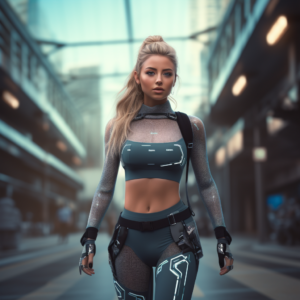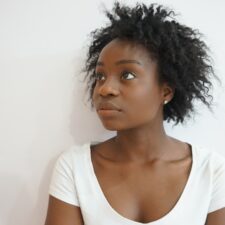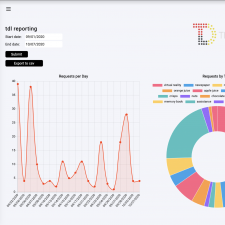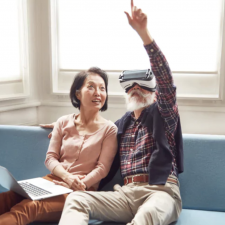Predicted Trends for the Future of Fashion – Trends for the Fashion Industry and Businesses.
AI and advancements in technology are poised to change the fashion industry in unprecedented ways, alongside a need to transition to more sustainable materials and production. As recently seen at New York Fashion Week, Collina Strada utilised Midjourney to design the entire SS24 Collection, by feeding previous brand looks into the image generator and continuously refining the prompt to create the resulting collection.
Interested in what the future of the fashion industry may look like, experts at JOOR delved into the data and utilised AI image generation to visualise key predictions. They asked Chat GPT to forecast future fashion based on how fashion has changed through time and combined this with search data, projected industry growth data, and expert insight to produce the following images.

Wearables in Fashion
Wearables in fashion are set to be one of the largest growing markets by 2027, moving beyond more traditional smartwatches to creating garments that can read body metrics through sensors that are not visible to the human eye. Demonstrated within the AI imagery for the purpose of visibility, these sensors allow the wearer to track health metrics, as well as environmental triggers like heatwaves that may have an impact on the body. These can be incorporated into activewear, streetwear, and even formal wear.
AI in Retail
AI shopping experience: AI can create a more personalised shopping experience for consumers. Retailers could reduce the need to stock physical items, instead allowing the consumer to select material, style and colour within an online software, and then 3D-print this to their own dimensions. Brands could also use it to establish best-selling elements of previous styles and utilise these within upcoming pieces.
Virtual try-on: In addition to creating products that fit their dimensions, consumers could also virtually try on ready-to-wear items. Current virtual try-on is available via AR filters, however, the future of this could include technology fitted into mirrors, whereby customers self-select the jacket or other item of clothing they’d like to try and then just need to look in the mirror to find the best fit for them.

Circular Fashion Economy
The circular fashion economy is expected to increase 96% by 2026, from its valuation in 2022 to 120 billion US dollars. While some brands are already offering the ability to have garments fixed in-store, or returned and recycled, this is predicted to transition with the development of advancing technology. JOOR sees the circular fashion economy as having the potential to become much more mainstream, using AI to visualise a store returns process whereby the garment is recycled, redesigned based on new trends, and/or reprinted.
Sustainable Fashion
Experts predict that in the coming decades, the vast majority of our clothing will consist of sustainable materials – for example, mushroom-based leather alternatives. Environmental impact can be reduced by altering the materials we utilise in clothing as well as addressing processes. One way to do this is through consumers ‘producing’ their own clothing by leveraging existing brand styles through AI programs and then 3D printing this in-store to meet their sizing requirements. These fit the consumers perfectly, minimising the need for returns, and when the consumer no longer likes the item or changes size, they can return the item to the store for a fee and then reprint this to generate a new garment.
Trends for Consumers
Nostalgia Revival
TikTok data shows that some of the most popular fashion trends in 2023 are Y2K with 23.1 billion views, and ‘90s Aesthetic’ with 3.2 billion views. Nostalgia in fashion typically occurs on a 20-year cycle, and with the rise of social media platforms, it has become easier than ever before to consult trends of former periods as a reference and draw from the metaphorical archives. In 20 years time, this could look like younger generations drawing on fashion that is typical of the 2020s, whether that’s the ‘clean girl’ aesthetic or more of a ‘barbiecore’ meets ‘fairycore’ twist, or even a look that’s more reflective of the loungewear and face masks popularised by the pandemic.

Cultural Fusion
As we continue to become a more globally connected world, JOOR predicts we see more of a fusion between the aesthetics of different cultures’ clothing. We’re likely to see people accumulating clothing that represents cultures they’ve grown up around, or areas where they’ve spent a lot of time, or even from countries that feel most like home. Not only that, but shared insights into the intention behind clothing, the psychology behind how clothing makes us feel and how it’s intended to make us feel, and production elements, will permeate.
Gender Neutral Fashion
Research has shown that in the UK, over three-quarters of shoppers are considering gender-neutral fashion, with experts at JOOR predicting this market will continue to flourish. Designers are likely to invest more time into establishing pieces that are truly genderless and fit the shape of the person. For example, by utilising fabrics that lend themselves to different body types, anyone can wear this clothing in a flattering way.
Tags: Fashion, Future Technologies

 Share On Facebook
Share On Facebook Tweet It
Tweet It


















